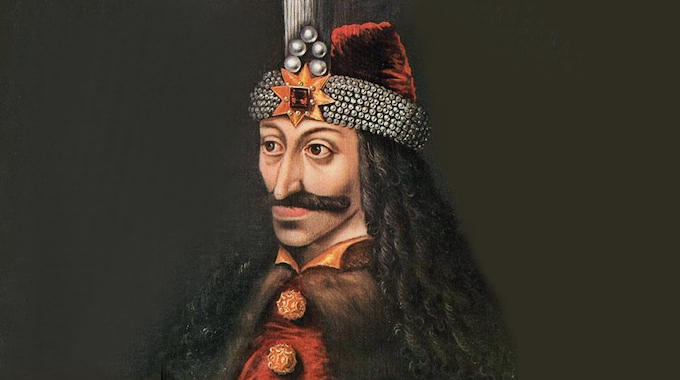Bram Stoker’s character, Dracula, is a Transylvanian Count with a castle located high above a valley perched on a rock with a flowing river below in the Principality of Transylvania.
This character is often confused with Vlad Tepes (Vlad the Impaler), sometimes known as Vlad Dracul, who was a Walachian Prince with a castle, now in ruins, located in the Principality of Wallachia. Because Bran Castle is the only castle in all of Transylvania that actually fits Bram Stoker’s description of Dracula’s Castle, it is known throughout the world as Dracula’s Castle. Chapter 2, May 5 of “Dracula” describes the Count’s castle as “. . . on the very edge of a terrific precipice . . . with occasionally a deep rift where there is a chasm [with] silver threads where the rivers wind in deep gorges through the forests.”
Bram Stoker never visited Romania. He depicted the imaginary Dracula’s castle based upon a description of Bran Castle that was available to him in turn-of-the-century Britain. Indeed, the imaginary depiction of Dracula’s Castle from the etching in the first edition of “Dracula” is strikingly similar to Bran Castle and no other in all of Romania. Stoker is widely purported to have used the illustration of Bran Castle in Charles Boner’s book, "Transylvania: Its Product and Its People", (London: Longmans, 1865) to describe his imaginary Dracula's Castle.
Dracula – as he is perceived today – is a fictitious character whose name derives from the appellation given to Vlad Tepes, the ruler of Wallachia from 1456-1462 and 1476, and who, for largely political reasons, was depicted by some historians of that time as a blood-thirsty ruthless despot.
Stoker’s character, Count Dracula, first appeared in the novel “Dracula”, published in England in 1897, by the Irish writer Bram Stoker. But the name “Dracula”, far from being a frightening term, derives from the Crusader Order of the Dragon with which Order both Vlad Tepes and his father had been associated. The rest of the Dracula myth derives from the legends and popular beliefs in ghosts and vampires prevalent throughout Transylvania.
Stoker’s Count Dracula is a centuries-old vampire, sorcerer, and Transylvanian nobleman, who claims to be a Székely descended from Attila the Hun. He inhabits a decaying castle in the Carpathian Mountains. In his conversations with the character Jonathan Harker, Dracula reveals himself as intensely proud of his boyar culture with a yearning for memories of his past. Count Dracula appears to have studied the black arts at the Academy of Scholomance in the Carpathian Mountains, near the town of Sibiu (then known as Hermannstadt). While Stoker named his Transylvanian Count “Dracula”, he was careful not to suggest an actual link to the historical character of Vlad Tepes. While Stoker’s character Van Helsing muses as to whether Count Dracula might be the Voivode Dracula, he obviously is not since Count Dracula of Transylvania is plainly not Prince Vlad Tepes of Wallachia and Stoker was disinclined at all to make his character a real person of historic significance.
In the villages near Bran, there is a belief in the existence of evil spirits called ghosts or “steregoi” (a variant of “strigoi”). Until half a century ago, it was believed that there existed certain living people – “strigoi” – who were leading a normal life during the day but at night, during their sleep, their souls left their bodies and haunted the village tormenting people in their sleep. These evil spirits haunt their prey from midnight until the first cockcrow, when their power to harm people faded. “The undead [i.e., ghosts, vampires] suffer from the curse of immortality,” writes Stoker, “they pass from one period to another, multiplying their victims, augmenting the evil in the world…” The Dracula character derives from these local myths.
As for Vlad Tepes, the ruler of Walachia, he does, indeed, has an association with Bran Castle. Vlad was involved in several campaigns to punish the German merchants of Brasov who failed to abide by his commands as regards their trade in his Walachian markets. Passage to Wallachia was through Bran, the closest gorge to Brasov, which connects with Targoviste, Vlad Tepes’ capital. The original customs houses at which taxes were collected from merchants entering Transylvania are still at the base of Bran Castle. The relationships with the Bran lords were not very cordial, as they were representatives of the Citadel of Brasov, which were hostile to Vlad the Impaler. It is not known if Vlad Tepes captured Bran Castle. Written documents do not describe it. The documents that do exist in archives with regard to Bran Castle, are mainly administrative and refer to the income and expenditure of the domain of the Bran Fortress, with little mention of political and military events.
However, in the fall of 1462, after the army of the Hungarian king, Matei Corvin, captured Vlad Tepes nearby the fortress of Podul Dambovitei, near Rucar, it appears that Vlad was taken to Bran Castle and locked up there for two months. This is affirmed in the recent volume Vlad The Impaler – Dracula, published by the Mirador Printing House, Arad, 2002, authored by Gheorghe Lazea Postelnicu. From here, Vlad was taken and imprisoned in the Visegrad Fortress.
Visitors to Bran Castle should make the distinction between the historic reality of Bran and the character of the Count in Bram Stoker’s novel. Dracula exists in the imagination.








